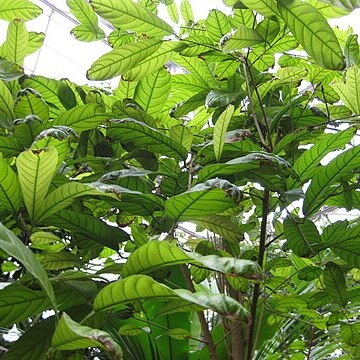Small to medium-sized, rarely large, trees; bole frequently sinuate, buttresses thick, rounded, concave, usually small. Crown irregular, oblong, sympodial, non-emergent. Bark surface usually grey mottled, smooth and hoop-marked, in large trees becoming patchily flaked, occasionally scroll-marked. Young parts usually +-caducous powdery tomentose. Leaves variable; nerves curved, usually somewhat oblique to the midrib; tertiary nerves ± reticulate, never truly scalariform; petioles not geniculate. Inflorescences irregularly branched, racemose or sometimes partially cymose, short, rarely spreading. Flower buds ovoid to lanceolate, of variable size. Calyx lobes +-valvate, subequal. Petals narrowly oblong, usually pale cream-white, not connate at base, falling separately. Stamens 15 in 3 verticils, single stamens alternating with pairs, short, the inner row slightly longer than the outer row; filaments short, dilated at base, ± tapering and filiform below anthers; anthers broadly oblong, latrorse, the inner pollen sacs smaller than the outer; appendage to connective short, rarely as long as anthers, +-deltoid, stout. Ovary ± broadly ovoid, conical, superior or semi-inferior, shortly densely pubescent, without distinct stylopodium; style columnar, short, stout, glabrous, somewhat expanded at apex and with a prominent conical 3-lobed stigma. Fruit calyx variable. Nut of variable size, broadly ovoid or globose, with or without a distinct apical style remnant; pericarp splitting along 3 sutures at germination; germination epigeal (sect. Sunaptea; some sect. Vatica) or hypogeal (some sect. Vatica) with the cotyledons remaining within the fruit; cotyledons, if free from fruit, magenta to pale yellow, usually non-photosynthetic; first pair of leaves opposite with interpetiolar stipules, rarely alternate; the succeeding leaves spiral.
More
Trees of main canopy and understory, unbuttressed, white resinous. Bark gray, smooth, often with annular striations. Stipules caducous, small; leaf blade ± leathery, pinnately veined, tertiary reticulate veins conspicuous, margin entire. Flowers in axillary or terminal cymose panicles, usually stellate pubescent. Calyx tube short; sepals narrowly imbricate, equal or subequal. Petals white, often with a mauve suffusion, lorate, large, falling separately. Stamens 15; filaments unequal, stout; anthers ellipsoid; connective appendages short, obtuse. Ovary ovoid, pubescent; style cylindric, short; stigma capitate or conic, prominent, entire or dentate. Nut globose or ellipsoid, 1-or 2-seeded; calyx segments equal or unequal, with 2 developed into long wings.

